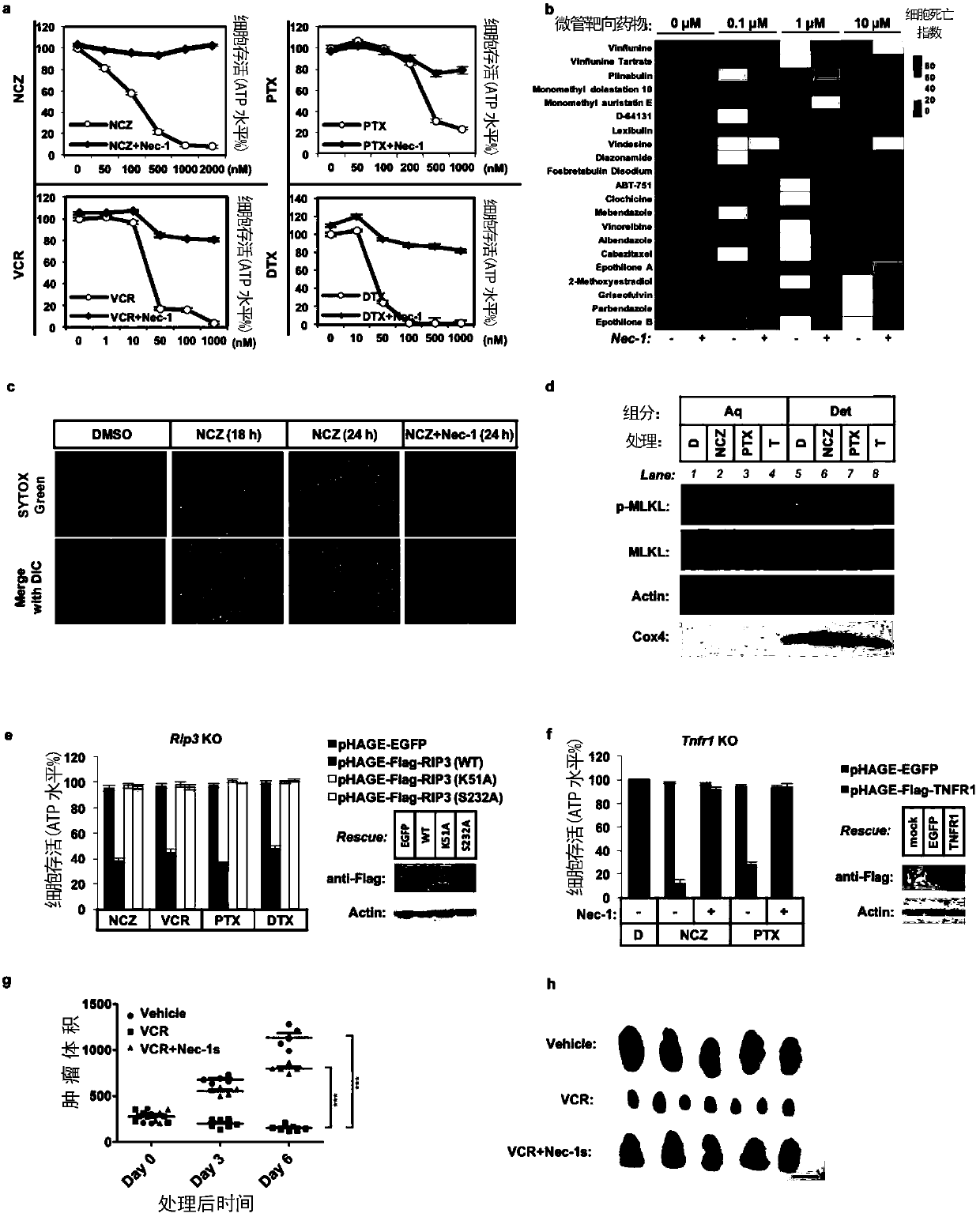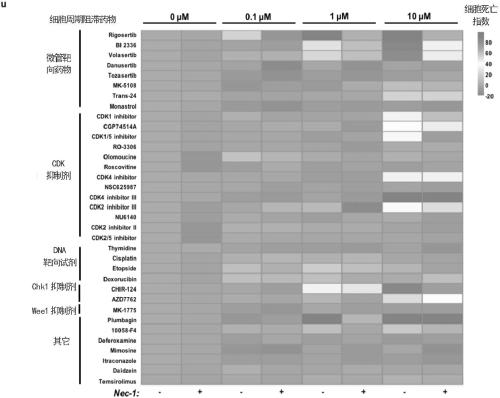Synergistic tumor inhibition composition and application thereof
A technology of tumor suppression and composition, applied in the field of pharmacy, can solve problems that cannot be explained and need further research
- Summary
- Abstract
- Description
- Claims
- Application Information
AI Technical Summary
Problems solved by technology
Method used
Image
Examples
Embodiment 1
[0208] Example 1, the mechanism of action of microtubule-targeting drug (MTA) causing cell necrosis in fibrosarcoma cells
[0209] Fibrosarcoma cells (L929) are a murine fibrosarcoma cell line that is very sensitive to TNF. After being stimulated by recombinant TNF, they can undergo membrane lytic death through programmed cell necrosis (hereinafter referred to as "cell necrosis"). The inventors used the sensitivity of L929 to TNF stimulation to establish a stable cell necrosis experimental system, trying to find necrosis inhibitors through large-scale compound screening. Unexpectedly, the present inventors discovered that microtubule-targeting drugs (MTA)—such as microtubule depolymerization drugs (Nocodazole, NCZ; Vincristine, VCR) and microtubule stabilization Docetaxel / docetaxel (Docetaxel, DTX) can directly induce necrosis of L929 cells, and this effect is concentration-dependent and can be inhibited by necrosis-specific inhibitor Nec-1. blocking ( figure 1 a). In Rip1 ...
Embodiment 2
[0216] Example 2, The necrosis caused by MTA in L929 cells is mediated by membrane-localized TNF
[0217] The inventor constructed the L929 cell line of Tnf gene knockout, and found that the cell necrosis caused by MTA was blocked ( image 3 a). This data is consistent with the results of Tnfr1 knockout in Example 1.
[0218] Furthermore, by neutralizing with an antibody against TNF, the inventors found that MTA-induced necrosis was largely suppressed ( image 3 b). Therefore, it was determined that the cell necrosis induced by MTA on L929 was mediated by TNF.
[0219] Raw264.7 cells and L929 cells were stimulated with LPS and NCZ respectively, and then the culture supernatant (CM) was taken to treat fresh L929 cells, and cell necrosis was detected within 12 hours. The inventors found that fresh L929 cells were very sensitive to activated Raw264.7 culture supernatant, and could undergo membrane lytic necrosis, but they did not respond to NCZ-treated L929 culture supernatan...
Embodiment 3
[0223] Example 3, MTA stimulates memTNF transcription through the JNK-cJun pathway
[0224] In order to further explore the mechanism of MTA regulating memTNF, first, the inventors detected whether the expression of TNF was activated at the transcriptional level after MTA treatment. The inventors found that the transcription inhibitor actinomycin D (ActD) can completely block the cell necrosis caused by NCZ and PTX ( Figure 4 a), indicating that MTA activates the transcription of Tnf gene. Real-time quantitative PCR results showed that after NCZ and PTX treatment, Tnf mRNA levels were upregulated over time ( Figure 4 b).
[0225] In order to find the transcription factor that regulates the expression of TNF after MTA stimulation, the inventors used L929 treated with MTA to perform RNA sequencing analysis. The results first verified that NCZ / PTX treatment activated the expression of endogenous TnfmRNA, after 3 hours and 16 hours of treatment , Tnf mRNA levels increased ove...
PUM
 Login to View More
Login to View More Abstract
Description
Claims
Application Information
 Login to View More
Login to View More - R&D
- Intellectual Property
- Life Sciences
- Materials
- Tech Scout
- Unparalleled Data Quality
- Higher Quality Content
- 60% Fewer Hallucinations
Browse by: Latest US Patents, China's latest patents, Technical Efficacy Thesaurus, Application Domain, Technology Topic, Popular Technical Reports.
© 2025 PatSnap. All rights reserved.Legal|Privacy policy|Modern Slavery Act Transparency Statement|Sitemap|About US| Contact US: help@patsnap.com



